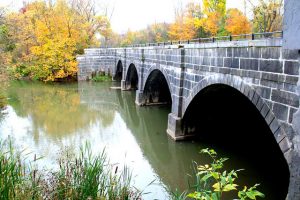WordPress is perfectly designed for taking maximum advantage of SEO “tricks”, and converting it to high-visibility conversion pages for your business. I’ve done this numerous times with clients, and have seen it have tangible effects.
Note: You can achieve the same effect I’m about to discuss with hand-coded websites or other CMS’s (Drupal for example), but the post-publish/share & category archives of WordPress are perfectly designed for vertical interlinking and conversion pages.
Here’s what I’m talking about:
Aqueducts

PageRank (Google’s Quality Juice that determines SERPs – Search Engine Results Pages) is like water, flowing from external sites that link to you, throughout your site, via internal links and URL. It gets diluted for each page beyond the initial outside-link. You want as much of this “water” to reach your landing pages. But here’s the problem: the hardest thing to garner as a digital marketer of a business website, is legitimate links to your landing pages. No one is going to do it, at least not legitimately – and that’s what we’re after, legitimate SEO improvement.
So, how do we increase the SERP visibility of our landing pages, when no one will link to us?
You go and write a bunch of blog posts, and one starts making waves. It gets shared by your friends, by fellow businesses, and maybe even gets picked up by a syndicate – great! However, that one beautiful article you wrote (“Running after Baby”, “Gluten Free Pancakes”, “Building Muscle while Working”) is going to get tons of links, but it won’t change you’re business’ bottom-line one bit, if your URLs and links aren’t designed properly.
Vertical Interlinking

Here’s how you take advantage of all this “water” coming in – vertical interlinking.
Let’s say your business sells adventure vacation packages, and one of your big sellers is “Kayak Vacations”. You could put this page as a sub-page under “packages”, but that would dilute its primacy in Google’s eyes: avpackages.com/kayak-vacations is much better than avpackages.com/packages/kayak-vacations. So, you want this page as close to the root as possible. That’s bonus #1.
Secondly, you want to have a conversion form on this page: “Book a Kayak Vacation” or “Contact Us About Kayak Adventures”. You can have a full-conversion page separate from your landing page, as long as you’re able to measure (through Analytics) the actions taken from customers visiting your landing page to taking the desired action (conversion).
Thirdly, you want a link to all of your landing pages in the footer template – it’s also direct access for the customer to hop between landing pages.
Now here’s the WordPress trick – make “Kayak Vacations” a Category Archive page. This means that it is a topic that you write blog posts about (so it gets updated regularly – another Google bonus), and it is a keyword/keyphrase that is included in the URL of every blog link that gets shared. This means, as you start writing future blog posts (“Packing Food for your Adventure Vacation”), you can put it under this category in your URL, and you will now be driving water upwards towards your landing page.*
Example: avpackages.com/kayak-vacations/packing-food-for-your-adventure-vacation – This post gets shared on Facebook, Twitter, Google+, LinkedIn, Blogger, etc. Your friends “like” it, share it, and post it on their respective social medias. Every time this link appears and gets shared, the keyphrase “kayak vacations” is being tied to your domain.
In your post itself, you put a link to the primary category (Kayak Vacations) – so all of your new, highly-shared posts are just one-step away from pushing all that PageRank up to your key landing page. This is called vertical interlinking – posts that drive external value upwards towards your landing pages.
You will need to have a custom WordPress theme designer or someone who can build on-top of your current theme to help you with these custom category archive pages. But, it’s highly worth it.
If you need help achieving this – Contact Me – and I can get you started with vertical interlinking.
*You can achieve category URLs without the “/category/” element with Yoast SEO plugin, or other no-category-base-URL plugins.